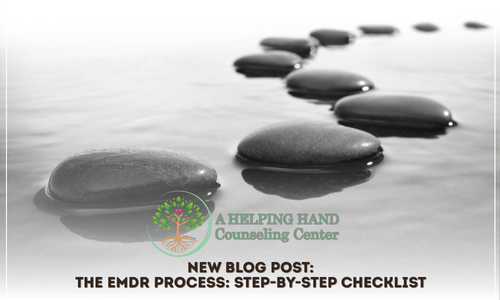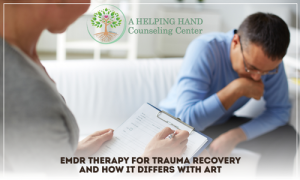
EMDR Therapy for Trauma: A Practical, Step-by-Step Guide to Healing
Trauma leaves a mark, even long after an event has passed. EMDR therapy (Eye Movement Desensitization and Reprocessing) is one of the most researched and effective treatments for trauma, PTSD, anxiety, and distressing memories. But people often ask the same question:
What actually happens in EMDR, and how do I know if it’s right for me?
This guide breaks down EMDR into clear steps, checklists, and practical actions so you can understand the process and feel confident about taking the next step.
What Is EMDR and How Does It Work?
EMDR helps the brain process memories that got “stuck” during moments of distress. Instead of reliving trauma over and over, EMDR helps the brain store the memory properly so it no longer triggers the same emotional and physical response.
It does this using a technique called bilateral stimulation, which may involve:
-
Moving your eyes side to side
-
Gentle tapping
-
Audio tones alternating between your left and right ear
As your brain processes the memory, emotional intensity decreases and a sense of clarity replaces the overwhelm.
Who Benefits Most From EMDR Therapy?
EMDR is highly effective for individuals dealing with:
-
Trauma and PTSD
-
Grief and loss
-
Anxiety and panic
-
Childhood trauma or adverse experiences
-
Military trauma
-
First responder trauma
-
Emotional neglect
-
Phobias
-
Stress from major life events
-
Distressing memories that feel “stuck”
If you feel triggered by something that happened months or years ago, EMDR can help your brain resolve it.
The EMDR Process: Step-By-Step Checklist
Below is a practical breakdown of the full EMDR sequence so you know exactly what to expect.
Step 1: Intake and History
Your therapist gathers background information to understand:
-
What you’ve experienced
-
How trauma affects your daily life
-
Any symptoms like panic, dissociation, nightmares, or avoidance
-
Your goals for treatment
Checklist for You:
-
Identify which experiences still feel “unresolved”
-
List current triggers
-
Note physical symptoms (tightness, panic, racing thoughts)
-
Clarify your main priorities for improvement
Step 2: Preparation
Before EMDR begins, your therapist teaches emotional-regulation tools so you feel safe at every step.
Common tools include:
-
Grounding skills
-
Mindfulness or breathing practices
-
Calm-place visualization
-
How to stop or pause processing if you feel overwhelmed
Checklist for You:
-
Practice grounding techniques daily
-
Identify a “safe place” image or memory
-
Learn how to communicate discomfort or the need for a pause
Step 3: Target Identification
Together, you will determine which trauma memory or belief EMDR will work on first.
Examples include:
-
A painful memory
-
A moment of fear or helplessness
-
A negative belief like “I’m not safe” or “I’m not good enough”
Checklist for You:
-
Identify the earliest memory you can recall connected to the issue
-
Describe how your body reacts to the memory
-
Note the negative belief attached to it
Step 4: Desensitization
This is the core of EMDR.
Your therapist guides you through bilateral stimulation while you focus on the memory. Your brain begins processing naturally, and emotional intensity decreases.
You may notice:
-
Less fear
-
More distance from the memory
-
New insights
-
Reduced physical tension
-
Emotional relief
Checklist for You:
-
Allow whatever thoughts or sensations come up
-
Stay open to the experience
-
Share changes or shifts as they happen
Step 5: Installation of Positive Beliefs
After the distress decreases, your therapist helps reinforce a healthier belief such as:
-
I am safe now
-
I am strong
-
I can trust myself
-
I am in control
-
I am worthy
Checklist for You:
-
Choose a positive belief that feels genuine
-
Rate how true it feels
-
Reinforce it through bilateral stimulation
Step 6: Body Scan
You check your body for leftover tension. If anything feels “stuck,” the therapist helps process it.
Checklist for You:
-
Note any physical reactions
-
Share anything that feels unfinished
-
Notice calm, grounded, or neutral sensations
Step 7: Closure
Each session ends with grounding, stability, and emotional safety.
Checklist for You:
-
Use your calm-place technique
-
Review what progress was made
-
Practice regulation tools between sessions
Step 8: Re-evaluation
At the next session, your therapist checks:
-
How you feel
-
Whether symptoms decreased
-
If the memory still feels charged
-
What should be processed next
Checklist for You:
-
Note any improvements
-
Track triggers or reductions in distress
-
Share any new insights
What EMDR Feels Like During and After Sessions
Most clients report:
-
Less emotional intensity
-
Fewer triggers
-
Better sleep
-
Reduced anxiety
-
Increased clarity
-
A feeling of distance from the traumatic event
-
Improved confidence or inner strength
Healing continues between sessions as your brain keeps processing.
When You Know EMDR Is Working
You may notice:
-
The memory no longer causes anxiety
-
You can talk about the event without shutting down
-
Your body feels calmer
-
You react differently to stress
-
You think more clearly
-
You feel more in control
How to Prepare for Your First EMDR Session
Do:
-
Get good sleep if possible
-
Hydrate
-
Eat before your session
-
Bring a list of triggers or memories
-
Practice grounding exercises
Avoid:
-
Consuming heavy caffeine right before
-
Rushing into your session last minute
-
Overthinking the process
Come with openness. Your therapist will guide each step.
EMDR as a Long-Term Healing Tool
EMDR does not erase memories.
It helps you store them in a healthy way so they stop controlling your emotional and physical responses.
Many clients improve significantly within:
-
6–12 sessions for single-event trauma
-
Longer for complex trauma or long-term emotional wounds
If You’re Considering EMDR
A Helping Hand Counseling Center offers EMDR and trauma-focused care from licensed clinicians trained in EMDR and related modalities.
If you’ve been carrying the weight of trauma, EMDR provides a structured and research-backed path toward relief, stability, and emotional strength.
Take the Next Step Toward Healing
If you’re ready to feel supported, understood, and guided by a licensed professional, A Helping Hand Counseling Center is here for you. Our team provides evidence-based therapy for individuals, couples, and families seeking real change.
Call us today or request an appointment online to get started.
A Helping Hand Counseling Center
- 303 Commerce Center Drive St. Cloud, FL 34769
- teamcare@ahhcounseling.com
- (407) 450-5985
- www.ahhcounseling.com
Subscribe to Our Newsletter
Posts Category
Most Popular Posts

Accelerated Resolution Therapy (ART): Rapid Trauma Resolution Without Retelling the Pain
Accelerated Resolution Therapy (ART) is a trauma-focused treatment that helps people heal faster by using a combination of guided imagery, eye movements, and memory reconsolidation.

Rapid Trauma Resolution with ART
Rapid Trauma Resolution with ART Therapy: Benefits, Process, and Local Treatment in St. Cloud, FL Accelerated Resolution Therapy (ART) is a brief, evidence-informed trauma therapy

Healing Trauma Through EMDR Therapy: How the Brain Finds Its Way Back to Calm
Trauma doesn’t always look like what we see in movies.It can come from a car accident, a painful breakup, an illness, or years of quiet
Subscribe to Our Newsletter




